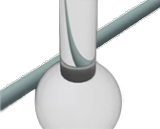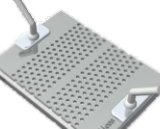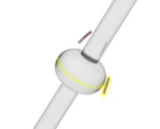Research Themes
Examples of research themes are shown below. For more details, please come to our laboratory and listen to the explanation while actually seeing the experimental apparatus!
- Development of an optical frequency comb light source using a micro optical resonator
Optical Frequency CombThe technology that won the Nobel Prize in Physics in 2005 was huge, and we are aiming to integrate it into chips such as silicon. Our goal is to integrate it into chips such as silicon. The miniaturization and integration of optical frequency comb light sources will open up many possibilities, from scientific research to industrial applications. Indispensable for automatic drivingLiDARDevelopment of a transmission capacity in excess of Tb/s.high capacity optical communicationLight Sources for Satellite Applications. Light Source for Satellites.......................quantum cryptographyRealization of the "K" series. High speed and high performance using ultrafast optical pulse trains.photoablation process... By incorporating the telescope into an astronomical telescopeAstronomical Observation Applications...Environmental SensorsThe laser light source is expected to be used for high-speed molecular spectroscopy and other applications. As described above, this is a laser light source that is expected to have many applications.
Toward the Era of Ultra-High-Capacity Optical Signal Processing

- Development of an ultra-compact spectrometer
photonic crystalThe performance limit of nanophotonics devices such as nanofabrication is determined by the precision of the nanofabrication process technology. Is it possible to exceed this limit? In photonic crystals with fluctuating structures, light is randomly localized in a "Anderson localization of lightIt is known that a phenomenon called "randomness" can be observed. Therefore, we are trying to improve the performance of the device by taking advantage of the randomness of the structure. For this purpose, we are usingIncorporate AI technology into data processing... Localization Patterns.Learning with SoftwareThe performance of a spectrometer can be improved if the unknown response can be predicted with a high degree of accuracy by making the spectrometer respond to the unknown response. As an example of one application, we aim to develop a high-performance spectrometer. Conventional spectrometers are expensive and large, so they are used only for limited applications.Security-enhancing technologyWe expect that it can be used for
Toward High Performance Nanophotonics Devices with Neural Networks

- Development of the world's smallest pulsed laser
Micro optical resonatorindicates such things as location of person or thing, location of short-term action, etc.gainand alsocarbon nanotubeThe goal of this project is to develop an ultrahigh repetition rate optical pulse laser light source by depositing erbium-doped glass on a silicon substrate. For this purpose, a chemical process called the sol-gel method is used to form erbium-doped glass on a silicon substrate to create micro optical resonators.Realization of microscopic lasersThe company is currently developing the design parameters required for pulsed lasers. Currently, we are deriving the design parameters required for the pulsed laser and developing a method for depositing carbon nanotubes, which is indispensable for the pulsed laser. The mode-locked laser we are developing is expected to have an output pulse train repetition rate of well over 100 GHz, which will be useful for processing new materials such as carbon fiber-reinforced plastics.High-speed laser processing applicationsThe following is a summary of the results of the study.
Ultra-compact lasers open up the world

- Realization of optical signal processing circuits using photonic crystals
photonic crystalusingOptical integrated circuits on silicon chipsWe have developed a wide range of optical devices. Using silicon photonic crystals, we have been developing a series of elemental devices that will become the next key elements in optical circuits, such as high-performance micro optical resonators, all-optical switches, electro-optical modulators, photodetectors, and optical demultiplexers.
Toward Realization of Ultimate Energy Savings with Optical Integrated Circuits

- Realization of the ultimate high-sensitivity sensor
The use of micro optical resonators allows light to be held in place, making it possible to detect small changes in dielectric constant and absorption with high sensitivity. In other words, it is possible to realize the ultimate high-sensitivity optical sensor. We are developing pH sensors and hydrogen sensors with the aim of developing truly usable sensors.
Toward usable sensor technology

Research Themes
- What is Professor Tanabe's education?
- About Research at Tanabe Lab.
- Must see! Laboratory Introduction Video
- Dig Deeper TANABE Lab.
- You get a good idea of what the lab is like!
- Laboratory Information Session for FY2024 Assignees
We are holding a lab information session for students who will be assigned in 2024. Open Labs are free to come and go as they please. Individual information sessions are also available at any time.
.
- 10/23 (Mon) 16:30- Briefing Session 1 (Location: Bldg. 14, 2F DS43)
- 10/27 (Mon) 18:00- Explanatory Session 2 (Location: Bldg. 14, 2F DR8)
- 11/ 2 (Thu) 16:30- 3rd briefing (Location: 14th Bldg., 2F DR7)
- Laboratory tours and open labs (as needed)
Individual Information Sessions and Lab Tours













